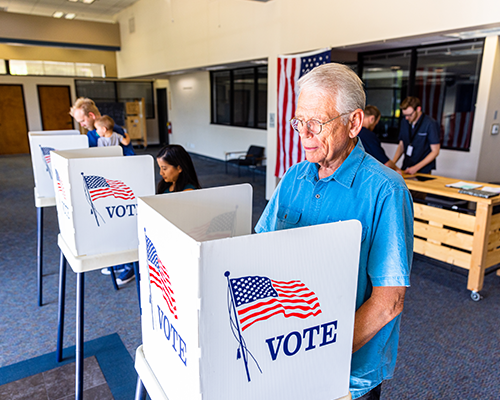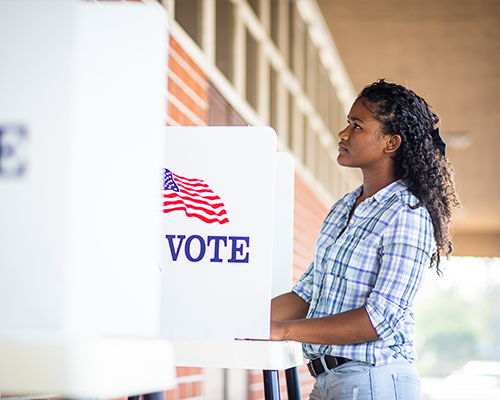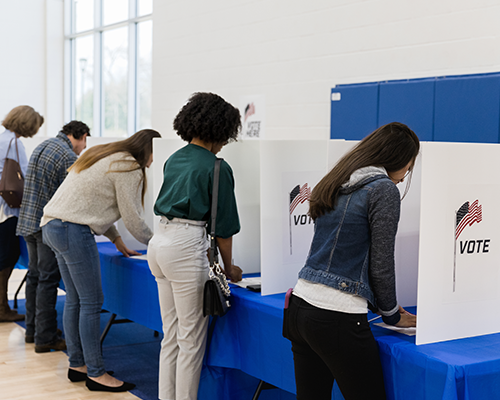
How Does Michigan Ensure Final Election
results are accurate?









Absentee Ballots
Absentee ballots can be processed and tabulated between 7 a.m. and 8 p.m. on any of the 8 days before Election Day in cities or townships in Michigan with a population of at least 5,000 or more people or where a county establishes an absent voter counting board for a city or township. All cities and townships may begin processing absentee ballots at 7:00 a.m. on the Monday before Election Day.
While ballots may be processed and scanned into ballot tabulators before Election Day, the results from this work are not published until Election Day.
Clerks’ offices will group the ballots as they come in, scanning them into their computer system and registering the day they are received. As ballots are scanned, the voter’s signature on file will come up on the clerk’s office computer, and a staff member ensures the signature on the ballot matches the one on file. The computer also tracks a running total of ballots that have been scanned, and the clerk’s office compares that against the number of physical ballots they have received.
If there is a problem with the signature or the ballot envelope is not signed, the clerk will contact the voter by phone, mail, or email within 48 hours and ask for the issue to be corrected.
Then, the clerk’s office will sort ballots by ward and precinct of the voter who submitted it. This data goes into frequent reports of votes by precinct, which are again compared against physical ballot totals to confirm accuracy.
After this step, ballots are moved into a secure storage room and stored in secure ballot containers. Clerks’ offices continue to recount and compare physical ballot numbers against computer totals on a regular basis.
In local elections offices, at least 2 election inspectors of different parties will then oversee the process of opening the outer green-and-white ballot envelope. Ballots remain in their secrecy sleeve. These ballots are then sealed in ballot bags, which are certified by the Board of County Canvassers on a routine basis. Two election inspectors sign a seal that goes on the bag; if anyone were to open the bag, there would be clear evidence of potential tampering.

Election Day
On Election Day, workers unseal any newly-arrived absentee ballots, and process them in the same way. Elections workers continually re-count all of the city or township’s received absentee ballots to ensure the number matches the total written on the bag’s outer seal and the number logged in the internal computer system.
Ballots are removed from their secrecy sleeves and run through the ballot tabulator. The tabulator scans the entire ballot. Secrecy sleeves and their accompanying ID numbers are retained separately to ensure ballot counts are accurate. After ballots have been tabulated by the machines and the polls are closed, the clerk’s office reports the results.
In-person votes are tabulated at the polling place as each voter scans in their paper ballot. Occasionally there will be a problem with a ballot, such as more than one candidate for the same position has been marked. In this case, the machine will flag that issue as the ballot is scanned, and the voter can choose to “spoil” their ballot and cast a new one. As soon as the voter tells the machine to “cast” their ballot, that vote is immediately counted, and the ballot is retained inside the machine.

No. It is not unusual for reported election results to change after election night, nor is it indicative of fraud or misconduct around the election. There are multiple steps in the process of counting the ballots to ensure the results are accurate.
The process of tabulating absentee ballots can take a while. Because absentee ballots are coming into election clerks offices, by mail or secure dropbox, until 8 pm on Election Day, that can lead to ballots needing to be processed even after Election Day. Results cannot be finalized until all ballots, absentee and in-person, are tabulated.
If more voters in one party vote absentee than in person, it can make vote totals look lopsided until all of the results are tallied.
Remember that when media outlets “call” the results of a race on election night, they are making a projection based on an incomplete count.
After all in-person and absentee ballots are counted, there are additional steps each local elections office completes to ensure results are finalized and accurate. These steps are canvassing, certification, and, if needed, recounts.
Like any other machine, a ballot tabulator can occasionally experience problems. With advance training, election workers are prepared to deal with any problems.
In the event of a power outage or similar issue, ballots that have been filled out by a voter but cannot be scanned are placed in a secure bag outside the tabulation machine. They will be tabulated by election workers once the technical issue is resolved.
Possible issues include: a single candidate selection bubble that is only partially filled in, or if multiple candidates have been voted for in the same race, or if there appears to be a write-in candidate specified whose name is not discernible. In this event, a bipartisan team of two election inspectors will work together to determine the voter’s intent.
If a ballot requires additional examination to determine if it is eligible to be included in the vote count, or to determine a voter’s intent in voting it, the board of canvassers or local election official follow rules established in state law to determine whether the ballot can be counted for some, all, or none of the races for which it was submitted. Generally, two election inspectors, one of each party will work together to determine the voter’s intent ensure the intended vote is what is tabulated.
After ballots are scanned into the ballot tabulator, the clerk’s office again counts the number of ballots in a given precinct against the number the computer system says have been scanned. Any differences are promptly investigated and reconciled. The Board of County Canvassers will also subsequently review unofficial results to ensure the number of ballots is equal to the number of votes tabulated by the machine. If there are questions, the Board of County Canvassers can ask the ballots to be examined in a public meeting, with the clerk and poll workers who handled them present.
The results of both absentee and in-person ballots are stored on digital memory cards in each ballot tabulator machine. These are in a secure compartment sealed with a tamper-evident lock. It will only be opened after polls close on Election Day.
Once polls close, at each polling place, two election workers of different political parties will enter a code given to them by the clerk of that city and township. This code will enable the tabulation machine to print off three paper reports with the results of the votes cast on that machine. The election workers who get these reports sign them.

The SD cards are then put into another sealed container and transmitted to the clerk’s office, as are all ballot bags containing absentee and in-person ballots. Two election officials of different parties travel together with these materials. The clerk is responsible for storing all ballot bags in a secure location in the event of a recount or other official request to inspect them.
The electronic results are loaded onto the clerk’s computer system upon arrival. The clerk receives one of the original paper copies of the results from each tabulation machine. The Board of County Canvassers will receive the second, and the county’s chief probate judge will receive the third. The results on these printed receipts are compared by representatives of each political party against the uploaded SD card results to ensure consistency and accuracy.
Ballots are maintained in secure ballot containers. They are maintained for at least 30 days, until the Board of State Canvassers has certified the election results, a recount has occurred, or both.
Checking the results
Because Michigan uses all paper ballots, and Michigan tabulation machines print the vote counts, there is always a paper record that can be reviewed. Elections offices can and often do conduct risk limiting audits after the election.
There are multiple ways elections offices in Michigan can check the processes they use while running elections. These include:
- A procedural audit
- This examines the election processes, such as ballot accounting and reconciliation determining how the election was run
- A risk-limiting audit (“RLA”)
- This involves a hand tally of a sample of ballots in a given race to verify the accuracy of the vote counting machines that were used
- An absentee counting board audit
- This examines the specific processes for tabulating mail-in absentee ballots
A risk limiting audit, or RLA, is a statistically significant hand recount of a subset of ballots in a given race that is used to verify that the machine-calculated results are accurate and led to the correct winner being declared in a given race. Such audits are conducted to ensure accuracy of results.
In certain limited cases – where an election is very close, or a candidate has a good-faith belief their race results were altered by fraud or error – a recount can be ordered. If a recount indicates the outcome of the election is different from initial vote counts, the results in the election can be changed.
In this day and age, this is, unfortunately, an important question. False information about voting and elections can easily spread online and on social media, so it’s always good to take a moment to consider the accuracy of any stories or claims you see.
Before you share or act on something you’ve read online, make sure the place you saw it is credible, verified, and has been backed up or supported by additional trusted sources.
There are clues and tools to help you hone your sense of whether what you’re reading online can be trusted.
No. Elections are run by trained election officials. However, these folks are human and, like all of us, sometimes they make mistakes. Nearly all problems in elections are the result of human error, and not the result of intentional fraud. There are many systems and processes in place to catch and fix any errors that may occur so that you can have confidence in the final results.
Certifying
Each bipartisan County Board of Canvassers has 14 days to complete their “canvass” of the election and certify the results. Canvassing is the process of reviewing the printed tabulation receipts, the totals reported by the SD cards from the tabulation machines, and any other information they believe is necessary to complete their review fully and accurately and to certify the results.
Then, the Michigan Board of State Canvassers, another bipartisan entity, examines and certifies the statewide results in all relevant elections within the following 6 days. Again, the Board of State Canvassers compares all printed results with digitally reported results to ensure accuracy and completeness. The duty to certify election results by each board of county canvassers and the Board of State Canvassers is required and not optional.

Contesting Election Results
Any recount that may occur will take place after both the county and state have completed their canvass and certification. Any candidate wishing to contest the results of an election may also proceed with a legal challenge in court. A judge will then review the merits of their claim, and determine if there is any reason to further inspect, recount, or otherwise investigate the way the election was conducted.
Presidential Election Results & The Electoral College
The process for finalizing the results for Presidential Elections follows a different timeline than other Michigan Elections. While the deadlines for local, county, and state certification remain the same, there are more steps to finalize how these votes translate into electoral college votes.
By December 11, 2024, Michigan’s governor must issue what is called a “Certificate of Ascertainment” after the statewide election results are certified. Seven copies of this certificate are made, and they show the final results in the Presidential election in that state. One copy is sent to the National Archives.
Six days later, on December 17, 2024, the members of the electoral college slate nominated by the party whose candidate is the winner of that state’s popular vote then meet. At this meeting, the electors record the candidate who they are voting for – in Michigan, the winner of the Presidential popular vote – and create six Certificates of Vote. Those certificates are paired with the six remaining Certificates of Ascertainment, and then signed, cealed, and certified.
The six sets of Michigan certificates – documenting the state’s electoral vote – must arrive in Washington DC by December 25, 2024. They are received by the President of the Senate (one of the roles of the Vice President of the United States) and the National Archivist.
By January 3, 2025, the Archivist then sends all 50 states’ electoral certificates to Congress, once the new Congress has assembled.
On January 6, 2025, Congress will count the electoral votes represented on those certificates. The Vice President, who serves as President of the Senate, then announces the results and declares the winner of the Presidential election.
